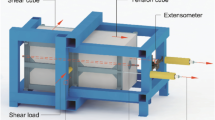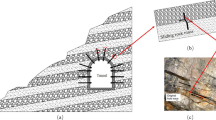Abstract
Conventional tunnelling methods (i.e., the drill and blast tunnelling method or the new Austrian tunnelling method) have been frequently applied for the construction of tunnels/caverns under a high overburden and with a large cross section. Under such adverse conditions, tunnel support materials may yield because of ground pressure and tunnel deformation. As a result, a tunnel may lose its stability due to a reduced effectiveness of the tunnel supports. Rock bolts have been widely used as an essential component of tunnel support, and many studies have been conducted on the performance of rock bolts in strengthening the jointed rock mass. However, there is a lack of understanding on the interface behaviour between the rock bolt and the bond material, especially the crack initiation and propagation inside the bond material. This study aims to investigate the interface behaviour between rock bolts and bond materials using laboratory tests (shear tests) and numerical simulations (Discontinuous deformation analysis). By assessing the impact of the key parameters in the rock bolting system, such as the ribs, rib angle, strength of the bond material and the confining pressure, we are able to better understand the supporting mechanism and the effects of rock bolting.











Similar content being viewed by others
Abbreviations
- DDA:
-
Discontinuous deformation analysis
- FEM:
-
Finite element method
- RA:
-
Rib angle
- MS:
-
Mortar strength
- CP:
-
Confining pressure
- x, y :
-
Points inside the DDA block
- u, v :
-
Displacements at any point (x, y)
- x 0, y 0 :
-
Specific point within the DDA block
- u 0, v 0 :
-
Rigid body translation at (x0, y0)
- r 0 :
-
Rotation angle of the block with respect to (x0, y0)
- \({\varepsilon _x},{\text{~}}{\varepsilon _y}{\text{~}}\) :
-
Normal strains in the x and y directions
- \({\gamma _{xy}}\) :
-
Shear strain
- \({K_{ij}}({\text{i}} \ne {\text{j}})\) :
-
6 × 6 sub-matrix that represents the contacts between blocks i and j
- \({K_{ij}}({\text{i}}={\text{j}})\) :
-
Block material stiffness matrix
- \({D_i}\) :
-
Deformation variables \(\left( {{u_0},~{v_{0~}},~{r_{0~}},~{\varepsilon _{x~}},~{\varepsilon _{y~}},~{\gamma _{xy~}}} \right)\)
- \({F_i}\) :
-
Loading on block i distributed to the six deformation variables
- UCS:
-
Uniaxial compressive strength
- \({\sigma _{xx}}\) :
-
Horizontal stress generated in the DDA model
References
Aydan Ö (1989) The stabilisation of rock engineering structures by rockbolts. Ph.D theis, Nagoya University
Aziz N, Jalalifar H, Remennikov AM, Sinclair S, Green A (2008) Optimisation of the bolt profile configuration for load transfer enhancement. Coal Operators’ Conference, University of Wollongong & the Australasian Institute of Mining and Metallurgy, pp 125–131
Cao C (2012) Bolt profile configuration and load transfer capacity optimisation. Ph.D theis, University of Wollongong
Goto Y (1971) Cracks formed in concrete around deformed tension bars. J Proc 68(4):244–251
Farmer IW (1975) Stress distribution along a resin grouted anchors. Int J Min Sci Technol 12:347–351
Goodman RE (1989) Introduction to rock mechanics, 2nd edn. Wiley, New York
Hyett AJ, Bawden WF, Reichert RD (1992) The effect of rock mass confinement on the bond strength of fully grouted cable bolts. Int J Rock Mech Min Sci 29(5):503–524
Jager AJ (1992) Two new support units for the control of rockburst damage. In: Kaiser PK, McCreath DR (eds) Rock support in mining and underground construction. Balkema, Rotterdam, pp 621–631
Jalalifar H, Aziz N (2009) Experimental and 3D numerical simulation of reinforced shear joints. Rock Mech Rock Eng 43(1):95–103
Japan Society of Civil Engineers (JSCE) (2010) Standard specifications for concrete structures—2007 “Design”. Japan Society of Civil Engineers, Japan
Kılıc A, Yasar E, Atis CD (2003) Effect of bar shape on the pull-out capacity of fully-grouted rockbolts. Tunn Undergr Space Technol 18(1):1–6
Kiyohara C, Hasegawa H, Suenaga S et al (1999) Studies on the mechanical properties of concrete—mortar strength and drying shrinkage—(in Japanese). Architectural Institute of Japan, Kyushu Branch, pp 85–88
Li CC (2010) A new energy-absorbing bolt for rock support in high stress rock masses. Int J Rock Mech Min Sci 47(3):396–404
Li C, Stillborg B (1999) Analytical models for rock bolts. Int J Rock Mech Min Sci 36:1013–1029
Li L, Hagan PC, Saydam S, Hebblewhite B, Li Y (2016) Parametric study of rockbolt shear behaviour by double shear test. Rock Mech Rock Eng 49(12):4787–4797
Lim HG, Maeda K, Murakami M (1998) Study on mechanical properties of concrete in early ages by triaxial compression test. Proc Jpn Concr Inst 20:577–582
Lutz LA (1970) Analysis of stresses in concrete near a reinforcing bar due to bond and transverse cracking. ACI J 67:778–787
Obara Y, Maeno Y, Kawano R, Ito F, Nakahara F (2002) Bond failure of rock bolts and cable bolts in a pull-out test. J Jpn Soc Civil Eng III 59(708):97–106
Ortlepp WD (1992) The design of support for the containment of rockburst damage in tunnels—an engineering approach. In: Kaiser PK, McCreath DR (eds) Rock support in mining and underground construction. Balkema, Rotterdam, pp 593–609
Sabo & Landslide Technical Center (STC) (2002) Soil-erosion control technology and Technical review and Certification committee: permanent anchor method (SSL-CE type)
Shi GH (1988) Block system modeling by discontinuous deformation analysis. Ph.D thesis, University of California, Berkeley
Stillborg B (1994) Professional users handbook for rock bolting. Trans Tech Publications
Tepfers R (1973) A theory of bond applied to overlapped tensile reinforcement splices for deformed bars. Ph.D thesis, Chalmers University of Technology
Tepfers R (1979) Cracking of concrete cover along anchored deformed reinforcing bars. Mag Concr Res 31:3–12
Yazici S, Kaiser PK (1992) Bond strength of grouted cable bolts. Int J Rock Mech Min Sci 29(3):279–292
Author information
Authors and Affiliations
Corresponding author
Additional information
Publisher’s Note
Springer Nature remains neutral with regard to jurisdictional claims in published maps and institutional affiliations.
Rights and permissions
About this article
Cite this article
Yokota, Y., Zhao, Z., Nie, W. et al. Experimental and Numerical Study on the Interface Behaviour Between the Rock Bolt and Bond Material. Rock Mech Rock Eng 52, 869–879 (2019). https://doi.org/10.1007/s00603-018-1629-4
Received:
Accepted:
Published:
Issue Date:
DOI: https://doi.org/10.1007/s00603-018-1629-4




